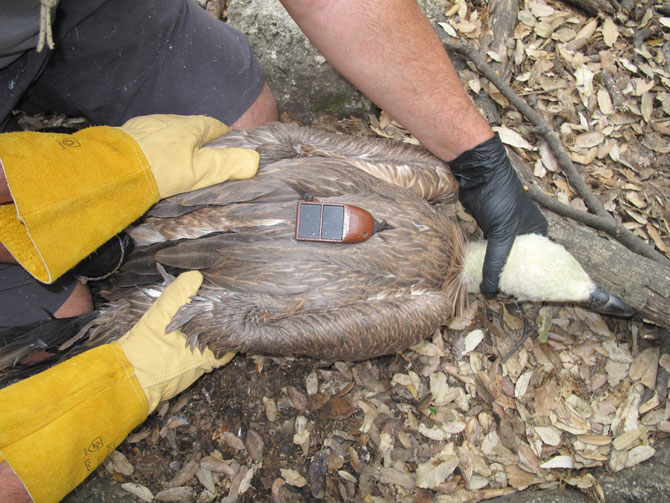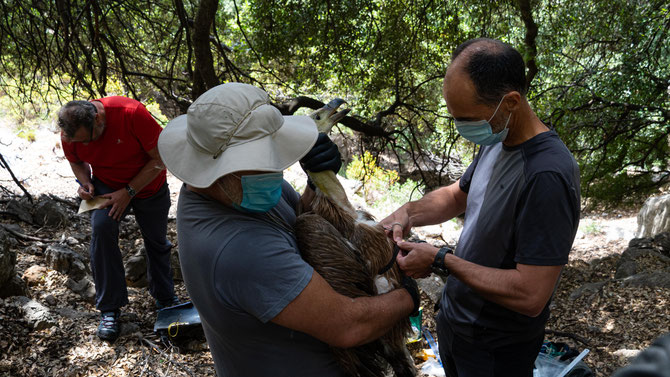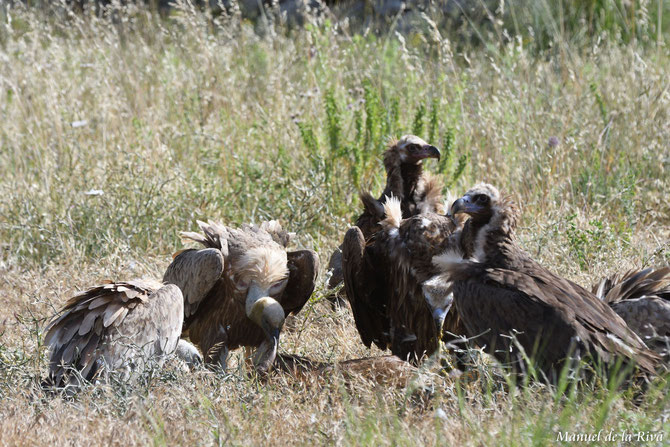
Griffon Vultures naturally colonised Mallorca in 2008 and joined the resident Cinereous Vultures, and a project is now studying this phenomenon.
For the first time, the project recently equipped a Griffon Vulture with a GPS tag in Mallorca, which will help understand the movements and behaviour of the species on the island.
Tagging the first Griffon Vulture in Mallorca

The Conselleria de Medi Ambient i Territori together with IMEDEA (CSIC_UIB) marked a Griffon Vulture in the Natural Park of the Tramuntana Mountains with a GPS tag provided by the Vulture Conservation Foundation (VCF). The bird tagged is three months old, and was also equipped with an identification ring to identify the individual in flight.
Studying Griffon and Cinereous Vultures in Mallorca
Dr Ainara Cortés-Avizanda from GEDA-IMEDEA (CSIC_UIB)-en casa, with the support of the VCF, is leading a research project to study the behaviour and use of space by the two vulture species that live in Mallorca. The project also examines the ecological, conservation and socioeconomic consequences of the arrival of the Griffon Vulture on the island. In addition to the Griffon Vulture, so far, three Cinereous Vultures are equipped with a GPS tag in Mallorca, providing great insight into the movements of the vultures that helps improve knowledge and management.
Griffon and Cinereous Vultures in Mallorca

At the beginning of the 21st century, only two species of scavenger birds lived in the Balearics: the Cinereous Vulture in Mallorca and the Egyptian Vulture (Neophron percnopterus) in Menorca. But in November 2008, another vulture species that was carried by strong winds from a storm arrived at the archipelago – the Griffon Vulture.
Strong westerly winds carried over a hundred individuals from mainland Spain and rather than leaving, they stayed and colonised Mallorca. Most of them were juveniles and, began to breed after reaching their sexual maturity. In the spring of 2012, the first chicks were born in the Serra de Tramuntana, solidifying the establishment of the species in Mallorca and expanding its range. There are presently about 15 pairs of Griffon Vultures that breed successfully. Scientific researchers, local administrations and conservationists have monitored the new species ever since, and it seems to have adapted quite well to the Balearic habitat.
The Cinereous Vulture, which is native to Mallorca, was rapidly diminishing and it was on the brink of extinction, but thanks to conservation efforts that reduced direct human persecution, among other actions, the population has multiplied by 10 in the last 40 years. The Fundació Vida Silvestre Mediterrània and the Department of Species Protection of the Balearic Govern estimate that in the 80s there were about twenty birds and, currently, there are around 200 Cinereous Vultures on the island, including approximately 39 breeding pairs nesting in the Serra de Tramuntana.
The following organisations and authorities have contributed in tagging this Griffon Vulture: GEDA-IMEDEA (CSIC_UIB), Vulture Conservation Foundation (VCF), Conselleria de Medi Ambient i Territori, Servicio de Agentes de Medio Ambiente, EBD (CSIC), IBANAT, GOB, and COFIB






